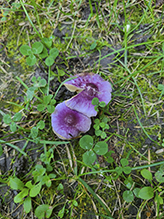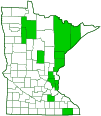Lilac Fibrecap
(Inocybe lilacina)
Conservation • Description • Habitat • Ecology • Distribution • Taxonomy
Conservation Status |
|
|||||||
| IUCN Red List | not listed |
|||||||
| NatureServe | NNR - Unranked |
|||||||
| Minnesota | not listed |
|||||||
Description |
||
Lilac Fibrecap is a small, colorful, gilled mushroom. It occurs in Europe and North America. In the United States it is common east of the Mississippi River and on the West Coast, and rare to absent between. It is found from August to October, alone, scattered, or in small groups but not clustered (gregariously). It grows on the ground under or near deciduous and coniferous trees. It has a mutually beneficial relationship (mycorrhizal) with the tiny rootlets of trees, absorbing sugars and amino acids while helping the tree absorb water. When it first appears, the cap is broadly cone-shaped and covered with fine, silky hair-like fibers. The margins are rolled inward. The upper surface is dry but may be tacky when moist. The color is described as “intense dark violet, dark purple, to blackish-purple.” As it ages it spreads out becoming flat, and it develops a small, raised, knob-like projection in the middle (umbonate), and the margins curve downward. The color toward the margins fade to lilac but the dark colors in the center do not completely fade. Mature caps can be 5⁄16″ to 13⁄16″ (8 to 30 mm) in diameter but they are usually no more than 11⁄16″ (18 mm) in diameter. The stalk is ¾″ to 13⁄16″ (20 to 30 mm) long and 1⁄16″ to ⅛″ (2 to 3 mm) thick. It is swollen or slightly bulbous at the base but is otherwise the same thickness from top to bottom. It is lilac or streaked with lilac when young, fading to whitish with age, yellowish or cream-colored at the base. When young, the gills are covered by a silky, mixed violet and white, protective veil (cortina) that extends from the margins of the cap to the stalk. When it deteriorates it sometimes leaves a hairy zone on the stalk but never leaves a ring. Mature gills are soft, closely spaced, and narrowly attached (adnate) to almost notched at the stalk. Between the main gills there are additional short gills. The gill surface is dark violet, colored like the cap, but the gills are white where they attach to the stalk, and the edges are cream colored. The flesh is whitish and thin, no more than 1⁄16″ (2 mm) thick. It does not discolor when cut or bruised. The odor is described as “strongly spermatic.” Like other Inocybe species, it contains muscarine and is poisonous. The spore print is brown. ------------------------------------------------- Note: This description is based upon that given in the 2018 study that separated the Inocybe lilacina group in North America into four distinct species. It differs significantly from the description in most field guides which were published before this study. |
||
Similar Species |
||
Habitat and Hosts |
||
On the ground under or near deciduous and coniferous trees |
||
Ecology |
||
Season |
||
August to October |
||
Distribution |
||||
|
Sources |
|||
| 10/3/2022 | ||||
Occurrence |
||||
|
||||
Taxonomy |
|||
| Kingdom | Fungi (fungi) | ||
| Subkingdom | Dikarya | ||
| Phylum | Basidiomycota (club fungi) | ||
| Subphylum | Agaricomycotina (jelly fungi, yeasts, and mushrooms) | ||
| Class | Agaricomycetes (mushrooms, bracket fungi, puffballs, and allies) | ||
| Subclass | Agaricomycetidae | ||
| Order | Agaricales (common gilled mushrooms and allies) | ||
| Suborder | Agaricineae | ||
Family |
Inocybaceae | ||
Genus |
Inocybe (fiber caps) | ||
This mushroom was first described in 1872 as Agaricus geophyllus var. lilacinus, a variety of White Fibrecap. In 1876 it was transferred to the genus Inocybe. In 1918 it was raised to genus level and became Inocybe lilacina, based on the lilac color and that the two species never occurred together in the same location. The reclassification was not accepted by all authors. A recent molecular DNA study (Matheny, P.B. and Swenie, R.A., 2018) showed that the mushrooms occurring worldwide and known as either Inocybe geophylla var. lilacina or Inocybe lilacina, were a group of twenty-nine distinct species, four of which occur in North America. The one North American species with small caps that are persistently dark violet or dark purple in the center, the color not fading with age, is Inocybe lilacina. |
|||
Synonyms |
|||
Agaricus geophyllus var. lilacinus Inocybe geophylla var. lilacina |
|||
Common Names |
|||
Lilac Fibrecap |
|||
Glossary
Cortina
On mushrooms: A thin, silky or cobwebby veil, attached to the cap and the stalk, that protects the developing gills.
Mycorrhizal
A symbiotic, usually beneficial relationship between a fungus and the tiny rootlets of a plant, usually a tree.
Umbonate
On mushrooms, having a distinct, raised, knob-like projection in the center of the cap.
Visitor Photos |
|||||
Share your photo of this fungus. |
|||||
| This button not working for you? Simply email us at info@MinnesotaSeasons.com. Attach one or more photos and, if you like, a caption. |
|||||
Sonia Christensen |
|||||
Purple Mushroom? Saw these purple colored mushrooms while hiking at Itasca State Park today. |
 |
||||
MinnesotaSeasons.com Photos |
|||||
|
|||||

Slideshows |
||

Visitor Videos |
|||
Share your video of this fungus. |
|||
| This button not working for you? Simply email us at info@MinnesotaSeasons.com. Attach a video, a YouTube link, or a cloud storage link. |
|||
Other Videos |
|||

Visitor Sightings |
|||||
Report a sighting of this fungus. |
|||||
| This button not working for you? Simply email us at info@MinnesotaSeasons.com. Be sure to include a location. |
|||||
| Sonia Christensen 9/18/2022 |
Location: Itasca State Park Saw these purple colored mushrooms while hiking at Itasca State Park today. |
||||
MinnesotaSeasons.com Sightings |
|||||
|
|||||

Created: 10/3/2022
Last Updated:

